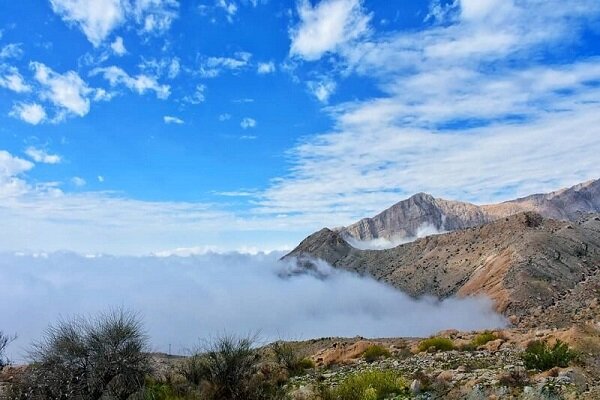The Geno Biosphere Reserve is situated to the very south of the Zagros Mountains, close to the Persian Gulf and the Hara Biosphere Reserve. Mountain ranges reach 3,000 m above sea level and separate the warm and humid Persian Gulf from the arid deserts of central Iran. Vegetation and microclimatic conditions vary with elevation throughout the biosphere reserve, while the valleys are home to several hot springs, according to the UNESCO website.
Inscribed in the UNESCO’s List of the biosphere reserves, the mountains play a great role in the precipitation rate of the province, while being a good option to hikers who choose winter late autumn to early spring for climbing as it has temperate climates during this season.
Ecological characteristics
The biosphere reserve is formed by the Geno Mountains, which rise above the Persian Gulf plains. Shallow slopes and plains surround the reserve to the south and east, while low hills are found in the north and west. The climate is arid but becomes semi-arid and cold at elevations of 2,300 m above sea level.
There are several endemic plant species, a high diversity of bird species, as well as endangered mammals.
Topographic Characteristics of Geno
Since a long time ago, Geno Mountain has been an area for escaping from the heat for the local people of Bandar Abbas as it has snowy and cold weather and, as a result, the lush slopes. The summer highland pastures of Kahnooj, Baq-e Kashan, and Chaho are some examples.
Due to the interstitial position of Geno Mountain and the rapid elevation changes, different microclimates exist in different geographical directions. The valleys and slopes of the Geno Biosphere Reserve have experienced impressive features and varieties in terms of phytogeography.
Flora of the region
The vegetation of this biosphere reserve consists of more than 360 species of vascular plants. Few of them are ferns and gymnosperm and most of them are flowering plants. As it is common in arid and desert regions, the two groups of woody plants and shrubs and annual short-lived plants are the most diverse.
Annual short-lived plants can grow rapidly and complete their life cycle during the short wet and rainy periods, and they usually spend long periods of drought as a seed. Shrubs and woody shrubs are also able to absorb deep soil moisture and withstand the dry season by creating a deep wide-spread root network, according to the destinationiran website.
Geographically, the vegetation of the Geno Biosphere Reserve belongs to Saha-Rasandi and Irano-Turani vegetation zones. However, there are sometimes one or more elements from other vegetation zones among Geno plants.
Geno Area is home to a number of Iranian exclusive plants, some of which are limited to Geno Mountain, including, Wendelboi, Onobrychis, Rechingerorum, Kickxia, Chamophytica, Isat, Raphanifolia, Fortuynia, Garcin, Donysia, Revolute, Andrachne, Amygdalus, Merxmmuelleri, Mentha, Mozaffariani, Zhumeria Majdae, Rosularia, Modesta, Pterocephalus, etc.
The vegetation of Geno Biosphere Reserve ranges varies from slopes to mountain peaks, including a variety of tropical trees, desert steppe, foothill steppe, and cold region vegetation species.
The different species of bushes have grown at the foothills among which there is a variety of Grasses, Astragalusgenus, and Acacia nubica.
Further up the slope, the species of plants change so that the wild almonds form the dominant species at a height of 1,800 meters. However, there are other species at a height of 2,300 meters.
Due to lower temperatures, cold trees such as pine, cedar, wild olive, and wild box have grown massively. It is surprising to see the pile of these trees in Hormozgan Province located in a warm and humid climate. Lightning burns the trees occasionally in this area. Other plants of the Geno altitudes are the different kinds of medicinal plants that attract researchers’ interest.
Fauna of the area
Among the invertebrates of the area, living especially around springs, we can mention the aquatic snails, terrestrial snails, and some kinds of worms. Most of the invertebrates in the area are arthropods, especially insects.
The researchers have identified and introduced several species of false scorpions and scorpions among the arthropods of Geno Mountains. There are also various kinds of orthopterans, coleopterans, Lepidoptera, bees, and Diptera in the area.
The vertebrates of this reserve include fish, amphibians, reptiles, birds, and mammals. Aphanius guinois is the only fish in the Geno area and is a unique fish of the Geno warm water in the world.
Five species of toads and frogs, mostly found in still waters around rivers and springs, form the amphibians of this biosphere reservoir, in the area.
Reptiles of this area are more diverse than amphibians and belong to two groups of lizards and snakes, including braid snake and echis.
The birds of Geno Biosphere Reserve live mainly in trees and shrubs. They are usually Passeriformes. However, there are also a number of predatory birds among the Geno birds. Today, as the extent of the area and the plain region has decreased, the previously reported birds living in the area such as grey francolin, francolinus, and bustards do not exist anymore.
The mammals of this area are not exceptional species and we can generally find in other natural habitats. But these species are remarkably diverse.
The accessible mounds and highlands of the Geno Area and the surrounding down-and-ups have been the perfect habitat for urials. But today, as a sheep habitat, Geno has not the same safety as the past. The rocky and inaccessible mountains of the area contain the last remnants of goats and bezoar ibex.
Other species of mammals in the region include leopard, hyena, wolf, fox, jackals, porcupine, and rabbit.
Socio-economic characteristics
According to a 2006 census, there are eleven villages, 1,683 households, and 7,581 people inside the reserve, comprising mainly indigenous communities of the Bandar Abbas tribe. The main activities of the villagers are farming, horticulture, and animal husbandry.
There are eight religious shrines in the reserve. These sites are well respected and draw pilgrims from surrounding areas. The cultivation of fruit trees, such as apple, lemon, and palm, has created a pleasant environment, which attracts visitors for recreation.
First Published in Tehran Times
























Your Comment